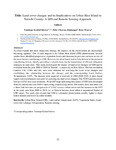Land cover changes and its Implications on Urban Heat Island in Nairobi County: A GIS and Remote Sensing Approach.

View/
Date
2019-04Author
Idowu, Temitope Ezekiel
Kiplangat, Nelly Cherono
Waswa, Rose
Metadata
Show full item recordAbstract
As cities expand and more megacities emerge, the impacts on the environment are increasingly becoming apparent. One of such impacts is the Urban Heat Island (UHI) phenomenon. Several studies have identified progressive vegetation losses and decrease in pervious surfaces as two of the main factors contributing to UHI. However, location-based studies help determine the pertinent contributing factors, thereby providing a valuable basis for the formulation of efficient mitigation strategies in such areas. This study investigated the impact of land cover changes on UHI and its evolution from the year 2000 to 2018 in Nairobi – a major city in East Africa. Medium resolution Landsat TM, ETM+ and OLI data were obtained for assessing the Land cover changes and establishing the relationship between the changes and the corresponding Land Surface Temperatures (LST). The datasets were acquired in intervals of 2002-2010-2018. A pixel-based supervised classification was used for assessing the land cover changes. The NDVI and emissivity for each LULC map were estimated. Final LST maps indicating the extents of UHI were developed from the emissivities and NDVI values using empirical equations. The results show that there was a direct link between the progression of LULC towards urbanisation and the increase in the LST in the study area from 2000 to 2018, i.e. as Nairobi became more urban it engendered higher of UHI values. The study also reveals that UHI is a dynamic phenomenon usually higher in dryer hotter months and lower in colder months.
